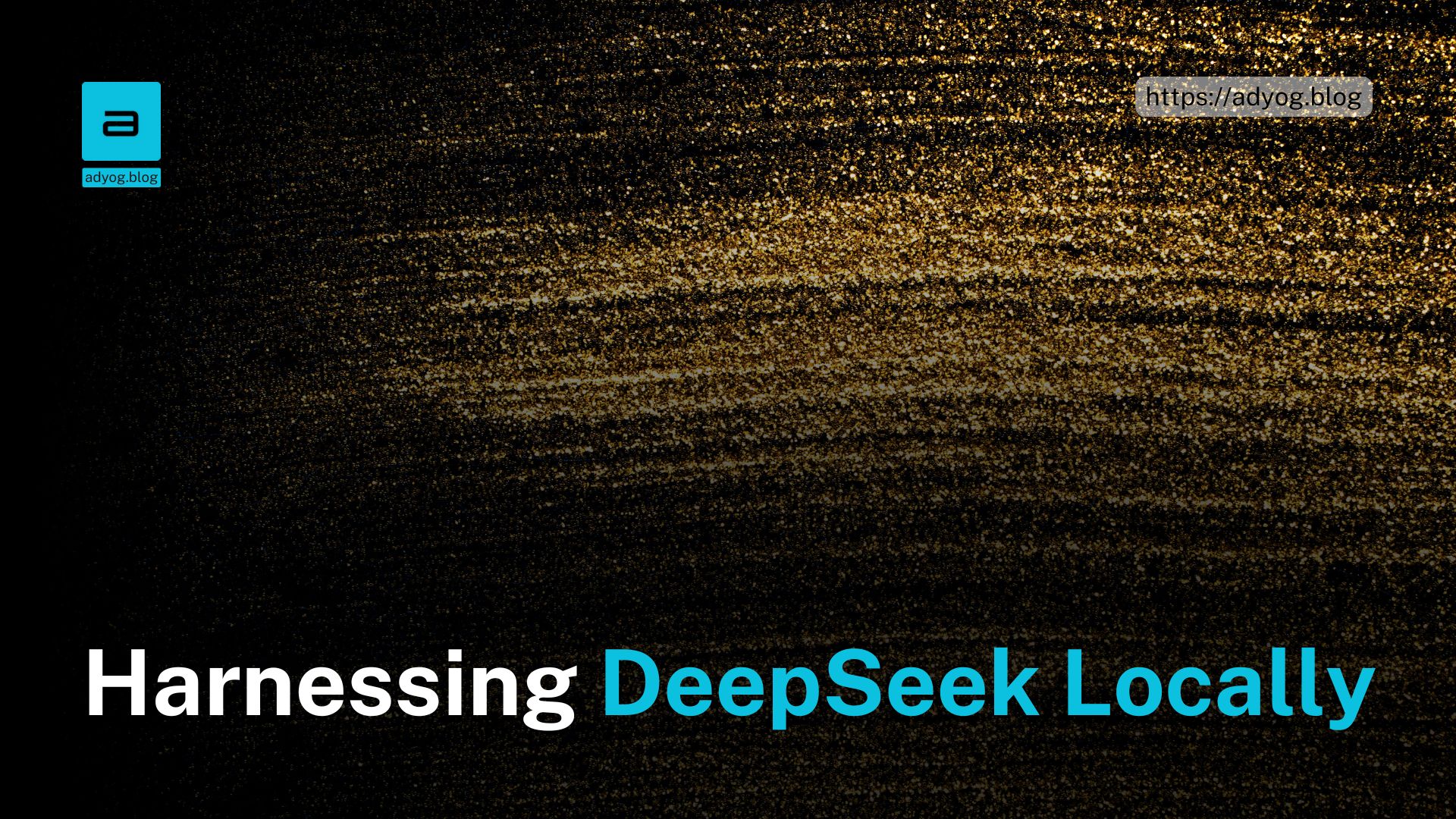Deploying AI models locally provides unparalleled control, security, and customization. Deploying DeepSeek-R1 Locally enables users to harness the power of an advanced open-source reasoning model for logical problem-solving, mathematical computations, and AI-assisted code generation.
This guide covers the entire deployment process, from system setup, GPU acceleration, fine-tuning, and security hardening to real-world applications, ensuring a smooth and efficient AI deployment on local hardware. Whether you’re a seasoned ML engineer or a tech enthusiast, this guide has you covered.
For more insights on the DeepSeek ecosystem and open-source AI trends, explore these related articles:
- DeepSeek-R1: The Open-Source AI Redefining Reasoning Performance
- DeepSeek-V3: A Bold Challenger in the AI Landscape
- Open-Source AI in 2025: Key Players and Predictions
1. Quick-Start Guide for Experienced Users
Step 1: Prepare System
Run the following command to update your system and install essential tools:
sudo apt-get update && sudo apt-get install -y curl gitStep 2: Install Docker
Use the following command to install Docker on your system:
curl -fsSL https://get.docker.com -o get-docker.sh
sudo sh get-docker.shStep 3: Install NVIDIA Docker Toolkit
Install the NVIDIA Docker Toolkit to enable GPU acceleration:
distribution=$(. /etc/os-release; echo $ID$VERSION_ID)
curl -s -L https://nvidia.github.io/nvidia-docker/gpgkey | sudo apt-key add -
curl -s -L https://nvidia.github.io/nvidia-docker/$distribution/nvidia-docker.list | sudo tee /etc/apt/sources.list.d/nvidia-docker.list
sudo apt-get update
sudo apt-get install -y nvidia-docker2Step 4: Run DeepSeek-R1
Pull and run the container:
docker pull ghcr.io/open-webui/open-webui:main
docker run --gpus all -d -p 9783:8080 -v open-webui:/app/backend/data --restart always ghcr.io/open-webui/open-webui:mainStep 5: Access the Web Interface
Navigate to http://localhost:9783 in your browser.
2. Technical Prerequisites
Hardware Requirements
- RAM: 32 GB (inference), 64 GB (fine-tuning)
- Disk Space: 50 GB (minimum) for Docker images and model weights
- GPU:
- Inference: NVIDIA GPU (RTX 3060+ recommended)
- Fine-tuning: A100 or multiple GPUs with 24 GB VRAM each
Software Requirements
- Bandwidth: 50 Mbps+ (for downloading ~15 GB of images and weights)
- Docker (with NVIDIA support)
- Python 3.8 or later
3. Introduction to DeepSeek-R1
DeepSeek-R1 is an open-source reasoning model designed for:
- Logical problem-solving
- Advanced code generation
- Complex mathematical reasoning
Unlike cloud-based AI models, local deployment ensures data security, customization, and cost efficiency.
4. Setting Up the Environment
System Update
Run the following commands to update your system:
apt-get update && sudo apt-get install -y build-essential curl gitCreate Swap Space
If your system lacks sufficient memory, configure a swap space:
sudo fallocate -l 16G /swapfile
sudo chmod 600 /swapfile
sudo mkswap /swapfile
sudo swapon /swapfileVerify Resources
- Check GPU readiness:
nvidia-smi - Check memory availability:
free -h
5. Installing and Configuring Docker
Install Docker
Run the following command to install Docker:
curl -fsSL https://get.docker.com -o get-docker.sh
sudo sh get-docker.shAdd NVIDIA Support
Follow NVIDIA’s official guide to install the NVIDIA Docker toolkit.
Configure Docker for Production
Set the container to always restart:
docker run --restart always ...6. Deploying Open WebUI
Pull the WebUI Docker Image
Use the following command to pull the image:
docker pull ghcr.io/open-webui/open-webui:mainRun the Container
Run the following command to start the container:
docker run -d --restart always -p 9783:8080 -v open-webui:/app/backend/data ghcr.io/open-webui/open-webui:main7. Leveraging GPU Acceleration
Install NVIDIA Drivers
Install the required drivers:
sudo apt-get install nvidia-driver-520Enable GPU Support
Run the container with GPU acceleration enabled:
docker run --gpus all ...Quantize the Model
Use FP16 quantization for faster inference:
lora quantize --model-path deepseek-r1 --precision fp168. Fine-Tuning DeepSeek-R1
Key Steps:
- Prepare tokenized datasets (e.g., Hugging Face).
- Run LoRA fine-tuning:
lora train --model deepseek-r1 --batch-size 32 --epochs 3
Warnings:
- Fine-tuning may require A100 GPUs or multiple GPUs to prevent OOM errors.
9. Performance Benchmarking and Monitoring
Metrics to Track:
- Latency: Response time per prompt
- Throughput: Prompts processed per second
- GPU Utilization: Check with
nvidia-smi
Monitoring Tools:
- Prometheus + Grafana: Set up dashboards for real-time performance insights.
10. Security Hardening
- Model Integrity Check:
sha256sum <model-file> - SSL Setup: Use Certbot and NGINX:
certbot certonly --standalone -d <domain>
11. Common Error Messages and Troubleshooting
| Error | Cause | Solution |
|---|---|---|
OOM during fine-tuning | Insufficient GPU memory | Use gradient checkpointing or reduce batch size |
nvidia-smi not found | Driver issue | Reinstall NVIDIA drivers |
12. Model Versioning and Weight Management
Use tools like Git-LFS or DVC to track model weight updates:
git lfs install
git lfs track "*.bin"13. Real-World Applications of DeepSeek-R1
- E-Learning: AI tutors for coding education.
- Legal Analytics: Contract analysis with domain-specific fine-tuning.
- Customer Support: On-prem chatbots for secure environments.
14. Conclusion and Next Steps
Deploying DeepSeek-R1 locally empowers users with unmatched flexibility and privacy. Follow this guide to harness its full potential for your use case.
15: DeepSeek-R1 in Azure Foundry: A Quick Start Before Local Deployment
For developers looking to quickly experiment with DeepSeek-R1 before setting it up locally, Azure AI Foundry provides an instant deployment option with built-in security and compliance features. This allows users to test the model’s capabilities in a cloud-hosted environment before transitioning to self-hosted, local deployment.
Why Start with Azure AI Foundry?
Before configuring DeepSeek-R1 locally, leveraging Azure AI Foundry provides a fast and secure way to explore its capabilities:
- No Setup Hassle – Deploy instantly without complex installation steps
- Pre-Configured Security – Built-in content filtering via Azure AI Content Safety
- Seamless API Access – Obtain an inference API and key for integration
- Playground for Testing – Run live queries before committing to a local setup
Getting Started with DeepSeek-R1 on Azure AI Foundry
16. Glossary of Terms
- Quantization: Reducing model precision for efficiency.
- Gradient Checkpointing: Saving GPU memory during training.
References
- DeepSeek-R1: Official GitHub Repository
- NVIDIA Docker Installation Guide
- Open WebUI: Official Documentation
- DeepSeek-R1: The Open-Source AI Redefining Reasoning Performance
- DeepSeek-V3: A Bold Challenger in the AI Landscape
- Open-Source AI in 2025: Key Players and Predictions





Leave a Reply